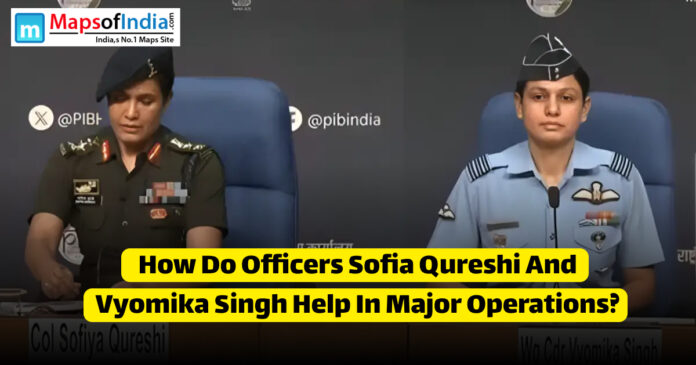Introduction: The Rise of Women in Indian Military Leadership
The Indian Armed Forces, long regarded as a defensive practice and a male-dominated order, have been undergoing an incremental but significant change. Among the most visible arrows of this change are two outstanding authorities—Lieutenant Colonel Sofia Qureshi and Captain Vyomika Singh. Both women have not only made records in their own right but have also become strategic investments in India’s developing image, both at home and abroad.
Their assistance in current high-profile functions—going from joint global exercises and border control to electronic warfare and tactical leadership garnered attention not just for their individual brilliance, but for what they represent: a new age of women soldiers redefining India’s military doctrine.
Lt Col Sofia Qureshi: A Trailblazer in Signals and Strategy
Early Career and Training
Lt. Col Sofia Qureshi was commissioned into the Army Signal Corps from the Officers Training Academy (OTA) in Chennai, She has constantly displayed a phenomenal capacity for management and technical skill. Her background in communication technology and cyber-security gave her an edge in a force increasingly reliant on digital warfare and real-time intelligence.
Her administration’s understanding was rather accepted on a multinational scene in 2016 when she became the first Indian woman to lead an army contingent in a multinational military exercise—Force 18—involving 18 ASEAN+ countries. This not only showcased India’s growing dedication to gender equality in security but also put Lt Col Qureshi in the multinational limelight.
Role in Joint Operations and Information Warfare
In contemporary years, Lt Col Qureshi has transitioned from symbolic administration roles to strategic assignment planning and undertaking. Her profession in certain contacts has earned her a prominent position in counter-terrorism and espionage coordination between armed units.
During the 2023 Northern Command exercise “Operation Iron Shield,” she led a classified operations cell coordinating real-time battlefield communication between infantry and artillery units.Sources in Army HQ assured that her findings played a vital part in evading collateral damage during revolutionary flush-out processes in Kupwara, Kashmir.
She has also been instrumental in rolling out next-generation Tactical Communication Systems (TCS) for the Indian Army, delivering secure, jam-resistant, and mobile networking media required for modern-day competitions. In the February 2024 stalemate along the Line of Actual Control (LAC), she reportedly supervised a team that monitored enemy contact practices, aiding Indian forces in blocking a scheduled intrusion by PLA branches.
Capt. Vyomika Singh: The Face of a New Generation
The Emergence of a Combat-Support Leader
Unlike her ageing companion, Captain Vyomika Singh describes the new wave of officials prepared with trendy warfare dynamics in mind. Introduced into the Corps of Signals in 2021, Capt Singh quickly rose to prominence during her posting in the high-altitude Siachen base, where she was responsible for setting up high-frequency management techniques and maintaining critical contact links in severe weather. Her field efficiency and resilience under pressure earned her a mention in the Army Day Honours of 2023. But it was her role during the 2025 Western Front escalation with Pakistan that cemented her place as a vital cog in India’s operational wheel.
Role in the May 2025 Operations: Tech Meets Tactics
In the early hours of May 8, 2025, when Indian intelligence confirmed a wave of drone infiltrations from across the border in Punjab and Rajasthan, Capt Vyomika Singh was part of the rapid response unit stationed in Bathinda. Her team activated electronic countermeasures (ECMs) that jammed GPS signals and neutralized over a dozen UAVs heading toward sensitive installations.
Military sources confirm that she led the mobile ECM deployment unit—a first for a woman officer in a live battlefield scenario. Her coordination with the drone surveillance wing allowed Army aviation teams to intercept remaining UAVs mid-air.
Later that week, during Indo-Pak naval tensions in the Arabian Sea, she was part of the Cyber-Electronic Warfare Coordination Cell in Mumbai, working under the Strategic Forces Command. Her unit tracked Pakistani naval vessel communications, providing actionable intelligence to INS Vikrant and INS Kolkata during joint manoeuvre drills.
Women in Combat-Support: Strategic Value and Symbolic Presence
Both Lt Col Qureshi and Capt Singh serve in the Corps of Signals—a component necessary for transmission, management, cyber-security, and electronic combat. Traditionally, these positions were overwhelmed by male officers with engineering experience, but the inclusion of ladies like Qureshi and Singh has redefined perceptions.
Psychological Impact and Morale Boost
Their presence in sensitive and high-pressure environments has had a positive psychological effect on the troops, particularly younger officers and jawans. Internal Army reports from 2024 indicated that units with women in leadership positions showed higher cohesion and discipline during simulated crisis drills.
Additionally, the visibility of women officers in combat-support operations has reinforced the Indian Army’s official line of “meritocracy over gender.” The Ministry of Defence has repeatedly emphasised that assignments are based on capability, not tokenism—a fact that both Qureshi and Singh embody.
India’s Gender Integration in the Military: The Bigger Picture
Policy Milestones Enabling Their Rise
Several landmark judgments and policy changes over the last decade have made it possible for officers like Qureshi and Singh to serve meaningfully in field roles:
2015: Women officers permitted to serve in high-altitude and conflict-prone areas.
2020: The Supreme Court of India grants permanent commission to women in all ten non-combat streams of the Army.
2023: The Army opens select combat-support command roles to women, including in Signals, Engineers, and Air Defence.
These shifts have led to a slow but steady increase in women in uniform, from just 3.8% of total commissioned officers in 2016 to 9.1% in 2025.
Challenges Still Faced by Women Officers
Systemic obstacles still exist in spite of these victories. Both Qureshi and Singh ruled over a largely male realm, frequently ordering them to prove their mettle.
Physical and Psychological Demands
Serving in domain units presents both material and psychological difficulties, particularly in high-altitude and insurgency-prone areas.Officers need to maintain peak performance while working in extreme conditions, long hours, and active mysteriousness. According to insiders, both administrators experienced developed strength sports, including simulations in Sub-Zero Survival Facilities (SZSFs) in Leh and Dehradun.
Command Acceptance and Leadership Bias
While Lt Col Qureshi has led troops in international forums and domestic drills, acceptance by subordinate male soldiers initially proved difficult. Over time, her decisions and calm leadership style won over sceptical units, but such acceptance is still not universal across commands.
Capt Singh, being younger and operating in more modern units, has reportedly faced fewer such obstacles, thanks to a generational shift in perceptions among newer recruits.
Their Public Perception and Media Presence
Role Models Beyond the Uniform
Both officials have slowly evolved into public figures, particularly as the media emphasizes their role in the national guard. They have been featured in discussions, security bulletins, and motivational seminars.
Capt. Vyomika Singh’s briefing during the drone infiltration situation went viral on social media, with her peace and transparency attracting praise across venues. Lt Col Qureshi was invited to speak at the 2024 Women in Security Conference in Singapore, where Col Qureshi was invited to speak at the 2024 Women in Security Conference in Singapore, where she examined gender-neutral leadership in security details.
Their growing public stature helps inspire thousands of young women from Tier II and Tier III Indian cities to consider careers in defense.
Future Outlook: Will They Break More Barriers?
Security insiders indicate that Lt Col Qureshi is being evaluated for a Brigadier-level management role in the next 2–3 years, which, if agreed, would earn her one of the highest-ranking working female officers in the Indian Army.
As per reports, Capt. Singh, is on the list for induction into the Army Cyber Warfare Wing, where her proficiency in real-time signal jamming and battlefield communication will be further edged. The wing is expected to play a key role in India’s upgradation of warfare capabilities, including AI-assisted command systems.
Conclusion: Beyond Representation, Toward Real Influence
The story of Lt. Col Sofia Qureshi and Capt. Vyomika Singh represent the competence, strategy, under pressure leadership, and trust placed in them by the military undergoing intense change.
As India’s protection challenges develop additional difficulties, with hazards going from cyber action and cross-border terrorism to drone raids and marine posturing, the role of officials like Qureshi and Singh will only evolve more necessary.
Their success isn’t just a story of two women in uniform—it’s a case study in how excellence, when given the opportunity, transcends all barriers.




